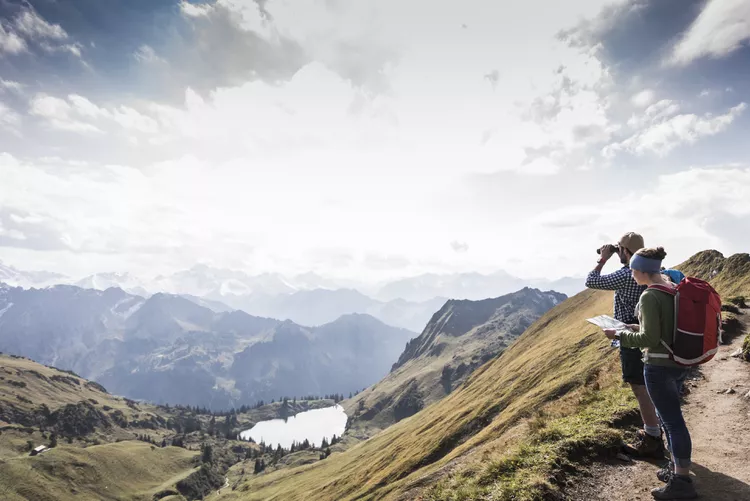Summary
If you love camping and hiking, you probably want to learn how to go backpacking. However, the great outdoors can be overwhelming for first-time backpackers. You may find yourself camping in the wilderness—miles from roads, facilities, and other people—but the solitude is one of the best reasons to hit the trail.
Don’t let the unfamiliar landscape or worries of being in the wild deter you from going backpacking. Here are some tips and advice to help beginner backpackers get started.
What Is Backpacking?
Backpacking, also known as tramping, trekking, or backcountry camping, is essentially a combination of hiking and camping in the backcountry. A backpacker typically carries camping gear including a tent, sleeping bag, cookware, food, and clothing in a backpack to hike to a backcountry camping destination.
Backpacking trips can vary significantly, ranging from short one-night excursions to multi-day journeys. Some backpackers begin their trek at one trailhead and end at another, while others embark on months-long distance end-to-end treks known as thru-hikes. Popular examples of such trails include the Pacific Crest Trail (PCT) and the Appalachian Trail (AT).
Nonetheless, to start backpacking, you don’t need to walk thousands of miles. Many scenic and moderate destinations are available for beginners.
Now that you’re interested in backpacking, let’s prepare for your adventure.
What Is Wilderness?
The Wilderness Act of 1964 is a federal designation that protects certain lands. Under this act, designated wilderness areas must be federally owned and managed, consist of at least five thousand acres, exhibit “substantially unnoticeable” human influence, offer opportunities for solitude and recreation, and possess “ecological, geological, or other features of scientific, educational, scenic, or historical value.”
Getting in Shape for Backpacking
If you’re a first-time backpacker or returning for the season, it’s essential to get in shape before hitting the trail. Backpacking can be more challenging than hiking due to the added weight of camping gear.
To prepare, begin hiking at low mileages with a lightweight pack. Gradually increase your mileage and add weight as your trip approaches. The more physically prepared you are, the better your experience will be on the trail.
If you find yourself short on time for training, that’s understandable, but make sure to lighten your load. Pack only the essentials and lightweight gear, and consider starting with a destination relatively close to the trailhead.
Now that you are in shape for your trip, what should you pack in your backpack?
Backpacking Gear
The primary goal of most backpackers is to keep their pack light while ensuring they have all essential gear for a comfortable trip.
Ultimately, all you need for a successful backpacking trip are food and shelter. While there are essential items every backpacker will want to carry, some items can be shared among a group to spread out the weight.
Before heading out, use a backpacking checklist to ensure you haven’t forgotten anything crucial, focusing on leaving non-essentials behind. Each ounce you lighten your pack makes hiking much easier.
With everything packed and ready, where should you consider going?
Where to Go Backpacking
National and state parks, wilderness, and forest areas serve as popular backpacking destinations. Check with your local ranger station for commonly traveled routes. Additionally, your local camping and outdoor retail store can be a valuable resource for maps and guides.
Ideally, choose a spot near a creek, river, or lake to ensure access to water. Once you’ve selected your destination, be sure to obtain the necessary permits and review regulations regarding food storage, camping, and fires.
Having chosen a destination, what precautions can you take to stay safe in the wilderness?
Backpacking Safety
Do you have a map and compass or a GPS device? Moreover, do you know how to use them effectively?
Ensure you inform someone about your plans, including your destination and route, and remember to call them upon your return.
A small first-aid kit is crucial to bring along on any backpacking trip. Additionally, familiarize yourself with emergency resources available in the area where you’ll be backpacking. In case of a wilderness emergency, remain calm, formulate an action plan, and seek help if needed.
Backpacking Ethics
The Leave No Trace Foundation is a nonprofit organization that advocates for a set of values and ethics for campers and wilderness visitors. Most backpackers agree on the importance of “leaving no trace” and “packing out what you pack in.” The core principles of Leave No Trace encompass:
- Dispose of waste properly
- Leave what you find
- Minimize campfire impacts
- Respect wildlife
- Travel and camp on durable surfaces
- Be considerate of other visitors
Furthermore, check with the park or forest service ranger station for specific regulations pertaining to the area where you’ll be camping. Based on the season and region, rules may restrict campfires, enforce specific food storage practices, and designate areas closed for restoration. Generally, it’s advised to camp at least 100 feet away from water sources. Adhering to these regulations and core backpacking ethics helps conserve the wilderness for future generations.





